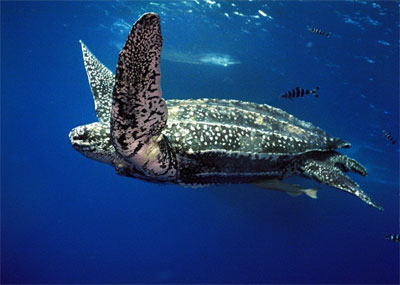 SKC Films Library SKC Films Library |
| SKC Films Library >> Science >> Zoology >> Reptiles and Amphibians >> Order Chelonia |
| Leatherback Sea Turtle Dermochelys coriacea Description The largest sea turtle in the world averages 4 to 6 feet in length, with the largest known specimen measuring just over 8 feet long; average weight is between 600 and 1,100 pounds, with the heaviest being just over 2,000 pounds. The leatherback gets its name from the fact that, instead of a hard shell, it has a leathery carapace composed of a mosaic of small bones covered by a firm rubbery skin. The only sea turtle without a hard shell, the leatherback's carapace is strengthened by seven longitudinal ridges on the back and five ridges on the underside.
The leatherback's skin is predominantly black , with varying degrees of pale spotting and a noticeable pink spot on the dorsal surface of the head. The upper jaw is deeply notched with two cusps, the lower jaw is hooked at the front. The paddle-like limbs are clawless. Distribution and Habitat The most widespread of all turtles, the leatherback is found throughout the Pacific, Indian and Atlantic oceans. Although most common in temperate and tropical waters, individuals have been seen as far north as Alaska and as far south as the southern tip of South America in the Pacific, and from Newfoundland to the southern tip of Africa in the Atlantic; they are also quite common in the seas off of Australia. A number of unique internal adaptations allow the leatherback to remain active in water below 40 degrees Fahrenheit. Diet The leatherback sea turtle preys primarily on jellyfish, but will also take sea urchins, squids, and other soft-bodied marine invertebrates, as well as fish, blue-green algae, and floating seaweed. Reproduction The courtship and mating behaviors of leatherbacks have not been observed, but tagging of females has shown that most return to the beaches were they were born to lay their eggs. It appears that most females only breed every two to three years, but they tend to produce 5 to 7 clutches per breeding cycle, with an average of 9-10 days between each clutch. When the female is ready to lay her eggs she will make up her way up the beach to a suitable spot, where she digs a depression, into which she deposits 80-85 (up to 100) white, spherical eggs (each of which is about 2 inches in diameter). After covering the eggs, she returns to the sea, only returning to the beach if she has more eggs to lay. Hatchlings emerge after 55-75 days, always at night. The sex of the brood is determined by the nest temperature -- a temperature of about 85.1 degrees Fahrenheit will produce a mix of males and females, while cooler temperatures will result in all males and warmer temperatures will produce all females. It is believed that leatherbacks achieve sexual maturity at 6-10 years, and may live up to 45 years. Other Habits and Behaviors Female leatherbacks only leave the water to lay their eggs; males never leave the water. Leatherbacks are extremely strong swimmers, capable of swimming against fast currents. They are also incredible travelers, with tagged individuals being tracked over thousands of miles of open ocean. In addition to their unusual swimming abilities, they are also capable of diving deeper than any other known sea turtle, with dives of up to 3/4 of a mile documented (deeper than the deepest dive ever recorded for a sperm whale, which is the deepest diving of all whales). Leatherbacks can also stay submerged for as long as 85 minutes. Conservation Status The leatherback sea turtle is endangered throughout its range. Development of many of the beaches on which females traditionally laid their eggs poses one of the turtle's biggest threats, along with the poaching of eggs. Open-sea net fishing is also a major detriment, as leatherbacks are frequently caught along with the fish and either drown or are killed for their meat after being hauled aboard with the fish. Many leatherbacks have also died as a result of swallowing floating plastic bags that were mistaken for jellyfish. Scientific Classification phylum Chordata
|
| SKC Films Library >> Science >> Zoology >> Reptiles and
Amphibians >> Order Chelonia This page was last updated on June 16, 2017. |
